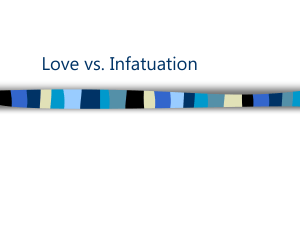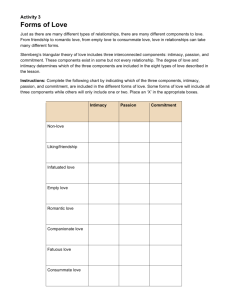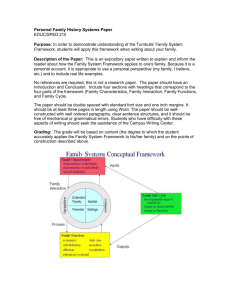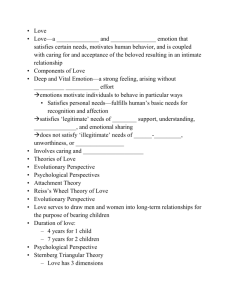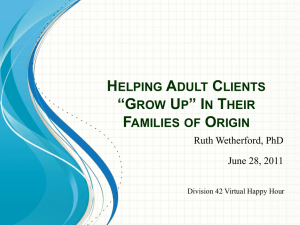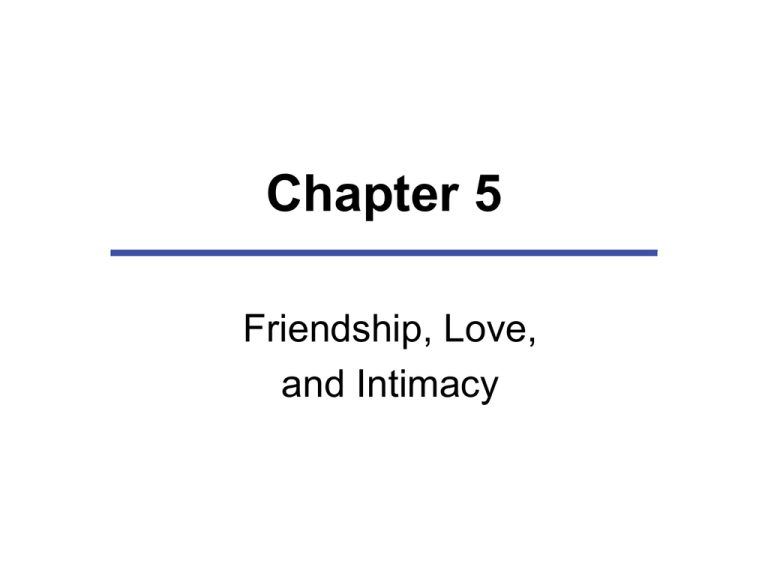
Chapter 5
Friendship, Love,
and Intimacy
Chapter Outline
The Need for Intimacy
• Gender and Intimacy: Men and Women as Friends
and Lovers
• Showing Love: Affection and Sexuality
• But What is This “Crazy Little Thing Called Love”?
• How Love Develops: Spinning Wheels and Winding
Clocks
• Importance of Love
• The Transformation of Love: From Passion to
Intimacy
•
True or False?
•
Men fall in love more quickly than do women.
True
•
•
•
Men fall in love more quickly than women, describe
more instrumental styles of love and are more likely
to see sex as an expression of love.
Because men have fewer deeply intimate, selfdisclosing friendships, when they find this quality in a
relationship they are more likely to perceive that
relationship as special.
Having more intimates with whom they can share
their feelings, women are less likely to be as quick to
characterize a particular relationship as love.
True or False?
•
Love is something experienced and
expressed similarly by people regardless of
their ethnic or racial backgrounds.
False
Love styles are linked to gender and ethnicity.
• Different styles tend to characterize Asians,
African Americans, Latinos, and Caucasians.
• Asian Americans have a more pragmatic style
of love than do Latinos, African Americans, or
Caucasians, and they place a high value on
affection, trust, and friendship.
• Latinos often score higher on the ludic
characteristics.
•
Intimacy
•
–
Research suggests that intimacy consists of four key
features:
1. Love and/or affection
2. Personal validation
3. Trust
4. Self-disclosure.
The more we feel as though another person likes us
or loves us, the more comfortable we will be sharing
our innermost feelings and revealing our most
personal thoughts.
The Intimacy of Friendship and
Love
•
•
•
Shared interests and values, acceptance, trust,
understanding, and enjoyment are at the root of
friendship and form a basis for love.
There are more similarities in what we want from
friends and lovers than there are differences.
Trust, enjoyment, acceptance, kindness, and warmth
are valued in both friends and romantic partners.
Companionate Marriage
Marriage wherein spouses are each other’s
best friends, confidants, and romantic
partners.
• Selecting a spouse on the basis of romantic
love may lead to a greater tendency to
idealize the partner, display affection toward
the partner, and to attach more importance to
sexual intimacy.
•
Love Across Cultures
•
•
90% of the 166 societies examined by William
Jankowiak and Edward Fischer recognize and value
love as an important element in relationships.
Love-based marriage validates the importance of
freedom from parental intervention and control,
establishes the independence of the conjugal family
from the extended family, and fits with the wider
social freedoms granted to adolescents and young
adults.
Gender Differences in Intimacy
•
•
•
•
To women intimacy means sharing love and affection
and expressing warm feelings toward someone.
To men, being intimate may mean engaging in sexual
behavior and being physically close.
Women express more empathy, being more likely
than men to understand what others are feeling.
Men associate intimacy with “doing” things together
or for another person and often find women’s need or
desire to “talk things through” puzzling.
Gender Differences in Saying
“I love you”
•
In a study of 147 never-married
undergraduate students designed to look for
and at gender differences in timing and
reason for saying “I love you,” Knox and
Zusman (2002) found the following:
– In heterosexual relationships, males say “I
love you” before their partners do.
– Males say “I love you” in part to increase
the likelihood that their partner will agree to
have sex with them.
Sex without Love, Love without
Sex
•
•
Pamela Regan (2000) determined that the link
between sex and love is really a link between sexual
desire and love, not between sexual activity and love.
In research with a sample of heterosexual women
and men in relationships, Regan found that the
respondents who felt the greatest desire for their
partners also reported the greatest amount of love
but that sexual activity levels were unrelated to the
amount of love respondents felt.
Central Attributes of Love
•
•
•
•
•
•
Trust
Caring
Honesty
Friendship
Respect
Concern for the
other’s well-being
•
•
•
•
•
•
Loyalty
Commitment
Acceptance of the
other
Supportiveness
Wanting to be with
the other
Interest in the other
Central Attributes of
Commitment
•
•
•
•
•
•
Loyalty
Responsibility
Living up to your
word
Faithfulness
Trust
Being there for the
other in good and
bad times
•
•
•
•
•
•
Devotion
Reliability
Giving your best
effort
Supportiveness
Perseverance
Concern about the
other’s well-being
Behavioral Expressions of
Love
Verbally expressions of affection, such as
saying “I love you”
• Revealing intimate personal facts
• Offering emotional and moral support in times
of need and showing respect for the other’s
opinion
• Expressing nonverbal feelings such as
happiness, contentment, and security when
the other is present
•
Behavioral Expressions of
Love
Providing gifts or small favors or doing more
than the other’s share of something
• Physically expressing love, such as by
hugging, kissing, and making love
• Tolerating and accepting the other’s
idiosyncrasies, peculiar routines, or annoying
habits
•
John Lee’s Six Styles of Love
Eros. Romantic or passionate love
2. Ludus. Playful or game-playing love
3. Storge. Companionate or friendship love
1.
John Lee’s Six Styles of Love
4.
5.
6.
Mania. A combination of ludus and eros, mania is
obsessive love, characterized by an intense love–
hate relationship.
Agape. A combination of eros and storge, agape is
altruistic love.
Pragma. A combination of storge and ludus,
pragma is a practical, pragmatic style of love.
Rubin’s Love Scale
•
•
In 1970, Zick Rubin developed a 13-item love scale.
Rubin found that there were four feelings identifying
love:
– Caring for the other; wanting to help him or her
– Needing the other; having a strong desire to be in
the other’s presence and be cared for by the other
– Trusting the other; mutually exchanging
confidences
– Tolerating the other; accepting his or her faults
Triangular Theory of Love
•
Views love as consisting of three
components:
– Intimacy
– Passion
– Decision/commitment
Triangular Theory of Love
•
•
•
•
•
•
•
•
Liking (intimacy only)
Romantic love (intimacy and passion)
Infatuation (passion only)
Fatuous love (passion and commitment)
Empty love (decision or commitment only)
Companionate love (intimacy and commitment)
Consummate love (all three)
Nonlove (absence of all three)
The Triangles of Love
Attachment Theory of Love
Views love as being similar in nature to
attachments we form as infants.
• The attachment (love) styles of both infants
and adults are:
– Secure
– Anxious/ambivalent
– Avoidant
•
Similarities Between
Attachment and Love
Attachment
Attachment formation and
quality depend on attachment
object’s responsiveness,
interest, and reciprocation.
When attachment object is
present, infant is happier.
Infant shares toys,
discoveries, and objects with
attachment object.
Love
Feelings of love are
related to lover’s
feelings.
When lover is present,
person feels happier.
Lovers share
experiences and goods
and give gifts.
Similarities Between
Attachment and Love
Attachment
Love
Infant coos, talks baby talk,
“sings.”
Lovers coo, talk baby
talk, and sing.
There are feelings of oneness
with attachment object.
There are feelings of
oneness with lover.
Important Factors in
Commitment
1.
2.
3.
Balance of costs to benefits: “What am I getting out
of this relationship?”
Normative inputs: Values about love, relationships,
marriage, and family.
Structural constraints: Depending on the type of
relationship different roles and expectations are
structured in.
Intimacy
•
Being physically limited
does not inhibit love
and sexuality any more
than being able-bodied
guarantees them.
Wheel Theory of Love
•
Love develops and is maintained through
four processes:
1. Rapport
2. Self-revelation
3. Mutual dependency
4. Fulfillment of intimacy needs
Reiss’s Wheel Theory of Love
The Clockspring Variation on
Reiss’s Wheel Theory
Styles of Unrequited Love
•
•
•
•
Cyrano style - Desire for a relationship
regardless of how hopeless.
Giselle style - Misperception that a
relationship is likely to develop.
Don Quixote style - Desire to be in love.
Anxious/ambivalent adults are most likely to
be Cyranos, avoidant adults to be Don
Quixotes and secure adults to be Giselles.
Stalking
Love obsessional stalking (erotomania) is
based on delusions in which the stalker
believes they are involved in relationships
with their victims.
• Simple obsessional stalking, where real
relationships exist or existed between stalker
and victim.
– It is used to punish the person who ended
the relationship or to try to force him or her
back into the relationship.
•
Jealousy
Occurs because of a partner’s real, imagined,
or likely involvement with a third person.
• Most likely in committed relationships
because of the presumed “specialness” of the
relationship.
• Fear of loss, coupled with insecurity,
increases the likelihood of jealousy.
•
Time and Romance
Time affects romantic relationships.
• The rapid growth of intimacy tends to level
off, and we become habituated to passion.
• Commitment tends to increase, provided that
the relationship is judged to be rewarding.
•

